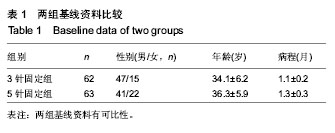| [1] Lieber RL, Silva PD. Equal effectiveness of electrical and volitional strength training for quadriceps femoris muscles after anterior cruciate ligament surgery. J Orthop Res. 1996; 14(1):131-138.
[2] Wright RW, Preston E, Fleming BC,et al.A systematic review of anterior cruciate ligament reconstruction rehabilitation: part II: open versus closed kinetic chain exercises, neuromuscular electrical stimulation, accelerated rehabilitation, and miscellaneous topics.J Knee Surg. 2008; 21(3):225-234.
[3] Snyder-Mackler L, Delitto A, Bailey SL, et al.Strength of the quadriceps femoris muscle and functional recovery after reconstruction of the anterior cruciate ligament. A prospective, randomized clinical trial of electrical stimulation.J Bone Joint Surg Am. 1995; 77(8):1166-1173.
[4] Andersson D, Samuelsson K, Karlsson J.Treatment of anterior cruciate ligament injuries with special reference to surgical technique and rehabilitation: an assessment of randomized controlled trials.Arthroscopy. 2009; 25(6): 653-685.
[5] Fithian DC, Paxton EW, Stone ML, et al. Prospective trial of a treatment algorithm for the management of the anterior cruciate ligament-injured knee. Am J Sports Med. 2005;33(3): 335-346.
[6] Bieler T, Sobol NA, Andersen LL, et al.The effects of high-intensity versus low-intensity resistance training on leg extensor power and recovery of knee function after ACL-reconstruction.Biomed Res Int. 2014; 2014:278512.
[7] Beynnon BD, Uh BS, Johnson RJ, et al.Rehabilitation after anterior cruciate ligament reconstruction: a prospective, randomized, double-blind comparison of programs administered over 2 different time intervals.Am J Sports Med. 2005; 33(3):347-359.
[8] Kostogiannis I, Ageberg E, Neuman P,et al.Clinically assessed knee joint laxity as a predictor for reconstruction after an anterior cruciate ligament injury: a prospective study of 100 patients treated with activity modification and rehabilitation.Am J Sports Med. 2008; 36(8):1528-1533.
[9] Chang MJ, Chang CB, Choi JY, et al.Can magnetic resonance imaging findings predict the degree of knee joint laxity in patients undergoing anterior cruciate ligament reconstruction?BMC Musculoskelet Disord. 2014; 15:214.
[10] Weiler A, Hoffmann RF, Bail HJ,et al.Tendon healing in a bone tunnel. Part II: Histologic analysis after biodegradable interference fit fixation in a model of anterior cruciate ligament reconstruction in sheep.Arthroscopy. 2002;18(2):124-135.
[11] 罗轶,彭永岳,陈伟兵,等.不同方法移植重建膝前交叉韧带的实验研究[J].中华创伤骨科杂志,2006,8(3):243-247.
[12] Paessler HH, Mastrokalos DS.Anterior cruciate ligament reconstruction using semitendinosus and gracilis tendons, bone patellar tendon, or quadriceps tendon-graft with press-fit fixation without hardware. A new and innovative procedure. Orthop Clin North Am. 2003; 34(1):49-64.
[13] Daniel DM, Fithian DC.Indications for ACL surgery. Arthroscopy. 1994;10(4):434-441.
[14] Bauer A, Börner M.Mobilization of the tibial insertion of the anterior cruciate ligament: new therapeutic possibilities in surgery of the cruciate ligament].Unfallchirurg. 1997; 100(9): 750-753.
[15] Bock GW, Bosch E, Mishra DK. The healed Segond fracture: a characteristic residual bone excrescence. Skeletal Radiol. 1994;23(7):555-556.
[16] Fehnel DJ, Johnson R.Anterior cruciate injuries in the skeletally immature athlete: a review of treatment outcomes. Sports Med. 2000; 29(1):51-63.
[17] Hess T, Rupp S, Hopf T,et al.Lateral tibial avulsion fractures and disruptions to the anterior cruciate ligament. A clinical study of their incidence and correlation.Clin Orthop Relat Res. 1994; (303):193-197.
[18] 高兴华,侯之启,刘永轶,等.两种缝合跟腱断裂方法的生物力学研究[J].广州医药,2014,45(2):20-24.
[19] 何余庆,郑杰,李贤海,等.锚钉结合Krackow和Bunnell缝合法治疗髌腱起点断裂[J].浙江创伤外科,2014,19(1):37-38.
[20] 田晓晨,王鹏程,杨勇.Krackow缝合法修复闭合性跟腱断裂[J].河北医科大学学报,2012,33(4):402-405.
[21] Akgün U, Erol B, Karahan M.Primary surgical repair with the Krackow technique combined with plantaris tendon augmentation in the treatment of acute Achilles tendon ruptures.Article in Turkish.Acta Orthop Traumatol Turc. 2006; 40(3):228-233.
[22] Pajala A, Kangas J, Siira P, et al.Augmented compared with nonaugmented surgical repair of a fresh total Achilles tendon rupture. A prospective randomized study.J Bone Joint Surg Am. 2009; 91(5):1092-1100.
[23] Türker M, Cetik O.Letter to the editor: The "Giftbox" repair of the Achilles tendon: a modification of the Krackow technique. Foot Ankle Int. 2009;30(10):1027.
[24] Lui TH.Surgical tip: Repair of acute Achilles rupture with Krackow suture through a 1.5 cm medial wound.Foot Ankle Surg. 2010; 16(1):28-31.
[25] White KL, Camire LM, Parks BG, et al.Krackow locking stitch versus locking premanufactured loop stitch for soft-tissue fixation: a biomechanical study.Arthroscopy. 2010;26(12): 1662-1666.
[26] Deramo DM, White KL, Parks BG, et al.Krackow locking stitch versus nonlocking premanufactured loop stitch for soft-tissue fixation: a biomechanical study.Arthroscopy. 2008; 24(5): 599-603.
[27] Bumbasirevi? MZ, Andjelkovi? S, Lesi? AR,et al.Operative treatment of flexor pollicis longus tendon with Krackow suture, functional results--preliminary results.Article in Serbian. Acta Chir Iugosl. 2010;57(4):15-17.
[28] Kara A, Sari S, ?eker A,et al.Osteotendinous repair of bilateral spontaneous quadriceps tendon ruptures with the Krackow technique in two patients with chronic renal failure.Acta Orthop Traumatol Turc. 2013;47(1):68-71.
[29] 张春礼.ACL移植重建的临床相关研究[D]. 第三军医大学.2004.
[30] 滕学仁,丁利琼.关节镜下中1/3髌腱移植重建膝后十字韧带[J].中华骨科杂志,2001,21(10):589-592.
[31] Chun CH, Han HJ, Lee BC, et al. Histologic findings of anterior cruciate ligament reconstruction with Achilles allograft. Clin Orthop Relat Res. 2004;(421):273-276.
[32] Shao DC, Chen BC, Gao SJ, et al.Arthroscopic simultaneous reconstruction of posterior cruciate ligament using double femoral tunnel technique and anterior cruciate ligament with achilles allograft].Zhonghua Wai Ke Za Zhi. 2008; 46(2): 94-97.
[33] Jagodzinski M, Geiges B, von Falck C, et al. Biodegradable screw versus a press-fit bone plug fixation for hamstring anterior cruciate ligament reconstruction: a prospective randomized study. Am J Sports Med. 2010;38(3):501-508.
[34] Taylor DC, DeBerardino TM, Nelson BJ, et al.Patellar tendon versus hamstring tendon autografts for anterior cruciate ligament reconstruction: a randomized controlled trial using similar femoral and tibial fixation methods.Am J Sports Med. 2009; 37(10):1946-1957.
[35] van Eck C, Working Z, Fu F. Current concepts in anatomic single- and double-bundle anterior cruciate ligament reconstruction. Phys Sportsmed. 2011;39(2):140-148.
[36] Yagi M, Wong EK, Kanamori A, et al. Biomechanical analysis of an anatomic anterior cruciate ligament reconstruction. Am J Sports Med. 2002;30(5):660-666. |

.jpg)
.jpg)